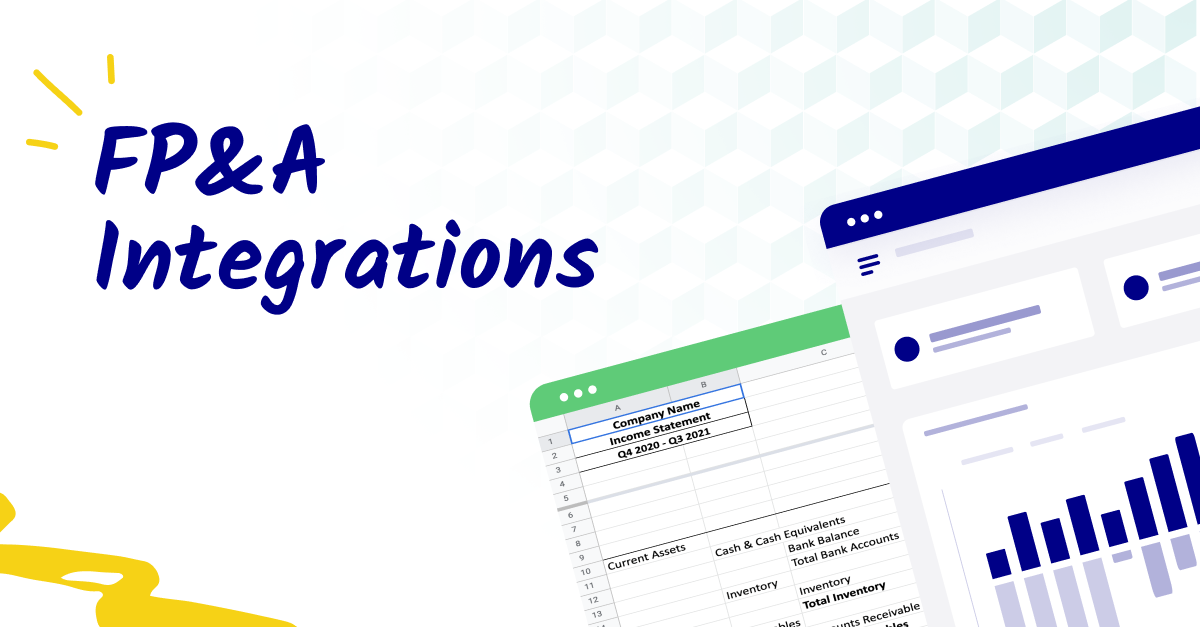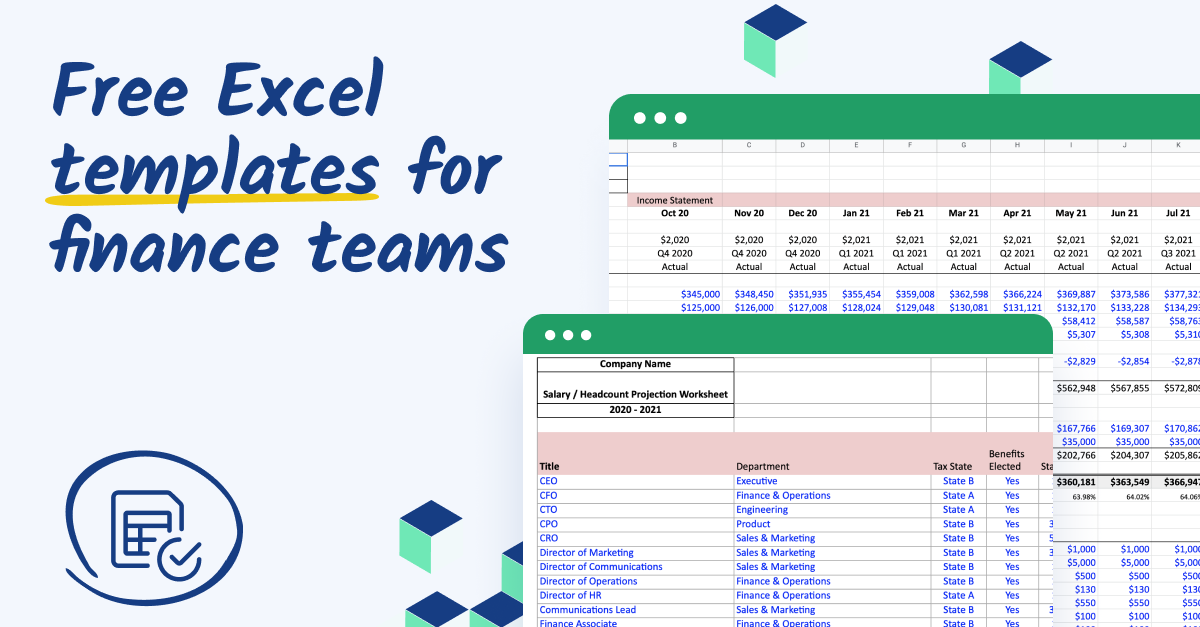The crucial role of FP&A integrations in business success
As your business grows, having a crystal-clear view of your company's financial health is essential for making smart decisions and optimizing performance.
Modern FP&A solutions are the key, offering real-time insights and precise forecasting for revenue, expenses, headcount, and inventory. But the real game-changer? It's the way they bring all your departments together—finance, sales, HR, operations, and more—into a unified view of your business.
Think of it as your financial command center, connecting data from systems like ERP, CRM, and HRIS. With the right FP&A integrations, your departments no longer work in isolation. Everyone understands how their actions impact the bigger picture, contributing to overarching business goals. This integrated approach also opens the door to comprehensive scenario planning, helping you spot vulnerabilities and stress test them against market shifts, regulations, or customer trends.
FP&A integrations are the foundation for successful enterprise performance management, helping your business adapt, thrive, and align with its goals in our ever-changing world.

Key considerations for choosing FP&A integrations
So, what kind of integrations should you look for? To answer that question, start by assessing your current tech stack.
Identify silos
Plenty of products described as FP&A solutions allow you to integrate your ERP or CRM, but not your HRIS. Do you have any major blind spots like this?
If so, you'll want to cover them ASAP. Clearing the gaps between business systems helps tackle the problem of data silos (a lack of transparency between different departments). HR having to manually enter data, for example, could lead to errors, resulting in flawed payroll forecasts or overly optimistic revenue projections. The right FP&A integrations help unify your planning processes.
Access real-time data
One of the most powerful uses of modern FP&A software is real-time views of everything from sales and expenditures to KPIs and budget variances—all from a single, centralized platform.
Real-time financial and operational data is important for multiple reasons. First, it allows you to take quick action if you need to. Pair that with scenario planning, and you'll be able to flexibly respond to crises or opportunities as they arise.
Next, real-time data allows your forecasts to be updated automatically. This means they become more accurate, giving you much better information for building financial plans. If you pair forecasts with rolling budgets, you can tweak those budgets based on the latest data, reducing waste.
Building flexible plans automatically grants you a competitive edge. So, prioritize real-time data flow in your FP&A integrations.
Assess scalability
How scalable is your current integrative software? Is it cloud-based? Does it support multiple currencies? Does it make it easy-to-build dashboards that can present key information and metrics to stakeholders in a digestible format?
As complexity increases, manually gathering data becomes less and less feasible. The best software will save you time by gathering and reconciling the data for you. This allows you to quickly gather insights and make informed decisions (i.e., to actually act on the data, rather than spend all your time managing it).
You want a single source of truth so that no matter how much headcount increases over time, everyone's on the same page. Save yourself the hassle of having to switch to a new tech stack as you grow by investing in one that matches your workflow now (i.e., spreadsheets in Excel or Google Sheets).
With these key points out of the way, let's look at some must-have integrations for your FP&A software.
Must-have integrations for modern FP&A teams
1. Accounting and finance systems
Your accounting and finance systems are the central hub of your business operations. Whether that's a more complex enterprise resource planning (ERP) program like NetSuite or a simpler tool like Quickbooks, you can't do financial planning without them.
By integrating with your FP&A software, you gain a clear view of expenses, accounts payable and receivable, and stock levels and procurement all in your centralized platform. From there, your ERP data can be put into a much more intuitive format—a spreadsheet. Once you have everything in spreadsheets (that usually takes quite a bit of time!), you can start your financial planning. No need for complex formulas, and no need to worry about errors.
You can then create financial models with confidence, knowing they're solid, based on the latest information, and sourced in real time. The ability to group and map data also helps speed up the financial reporting process.
2. Sales and marketing platforms
To understand cash flows and build accurate budgets, you need to understand your sales cycle. By integrating with your CRM, FP&A software can help you create accurate revenue forecasts. You get direct access to pipeline data and customer interactions. From there you can dig deep, gaining granular insights into what's causing any bottlenecks or customer churn.
You can also send this data back to your sales teams to boost their efforts with new insights. This not only helps with retaining customers but also with generating new leads.
Finally, through revenue recognition, CRM integration helps make GAAP compliance easier.
3. HR/ATS systems
Workforce planning is a huge part of your overall strategy. As one of your largest expenses, it's critical to get headcount right. It's also a good example of that interconnectivity we were talking about earlier since headcount is directly related to sales. Understanding the rhythm of your sales via your CRM will help optimize your headcount planning.
But to understand the implications of that forecast on your budget, you need to have a clear view of factors like compensation and benefits. That means integrating with your HRIS and ATS.
4. Billings and operations platform
By integrating your billings and operations platform, you'll gain immediate visibility into revenue and expenses. This helps you create budgets and forecasts that align with actual financial performance, reducing waste on variances.
Integrating with software allows you to gain a quick view of your operational expenses, and then break them down across departments This helps you allocate resources more effectively and pinpoint opportunities for cost control.
When you have a clear view of both revenue and expenses, you understand your cash flow. You know the time to expand and the time to scale back, without jeopardizing your short- or long-term liquidity position. This makes it one of the most important FP&A integrations.
5. Business intelligence
Your business intelligence tools help you understand all of the above—not just in isolation, but together. That means understanding the trends and gathering certain insights you might not gain from one tool but from the combination of two or more.
When you integrate your business intelligence tools with your FP&A software, you can bring the financial and operational data stored there to a platform that allows you to analyze it in depth. You can also tie this data to your key metrics, forecasts, and budgets.
You can then visualize these trends and other insights in a clear, easy-to-understand format. Think of beautiful dashboards that can be communicated to business leaders outside of finance.
With the right, holistic financial reports, the finance team can communicate why a certain strategy is a good idea right now. With a constant, real-time well of data, you can see how fast you're approaching your growth or performance targets, while the integrated, business-wide view helps ensure you’re doing so without exceeding your company’s risk tolerance.
Best practices for integrating with FP&A software
Integration is important, but not all FP&A tools are the same. You need to focus on security and data integrity, as well as regularly reassess your integration needs.
Focus on security
First, make absolutely certain your FP&A software is secure. This is important not only to protect against data breaches (you wouldn't want your customer lists to be leaked), but also to ensure compliance with evolving regulations. Data should be encrypted in transit and at rest, which also helps ensure its integrity. Look for software that is SOC 2 Type II compliant, meaning SOC 2 controls have been evaluated over a period of at least six months.
Ensure integrity
Your integrated business planning strategy is only as solid as the data it utilizes. Automation can help avoid human error, but there's more to ensuring data integrity.
Make sure your FP&A software automatically validates data integrity. This means assessing it for completeness and consistency, among other indicators. If a piece of data is invalid, the software should refrain from adding it to the database and alert you of the issue.
Regularly reassess
As your business expands, your FP&A integration needs could change. For example, if you begin scaling your sales channels, you might need to upgrade to a more advanced CRM. Reassess your needs at least once a year, or more frequently if you're expanding very quickly. Make sure the software you use has plenty of options for integration—not just out-of-the-box connectors, but also custom ones so you don't need to make a costly, time-consuming switch later (one that'll leave you temporarily blind to your overall business situation).
Conclusion: zeroing in on financial health
FP&A integrations are the secret sauce for modern business success. They provide the essential bridge between departments, offering a real-time, interconnected view of your company's operations.
With this integrated approach, you can navigate challenges, seize opportunities, and make informed decisions. As the business landscape continues to evolve, embracing FP&A integrations will keep your organization agile, resilient, and primed for growth.
Want to learn how Cube can help you on this journey? Request a free demo today.



.png)



.png)



![Top Pigment competitors & alternatives [2025 reviews]](https://www.cubesoftware.com/hubfs/pigment%20alternatives.png)

![14 best AI budgeting tools and software [2024 review]](https://www.cubesoftware.com/hubfs/Blog%20image%20%2868%29.png)